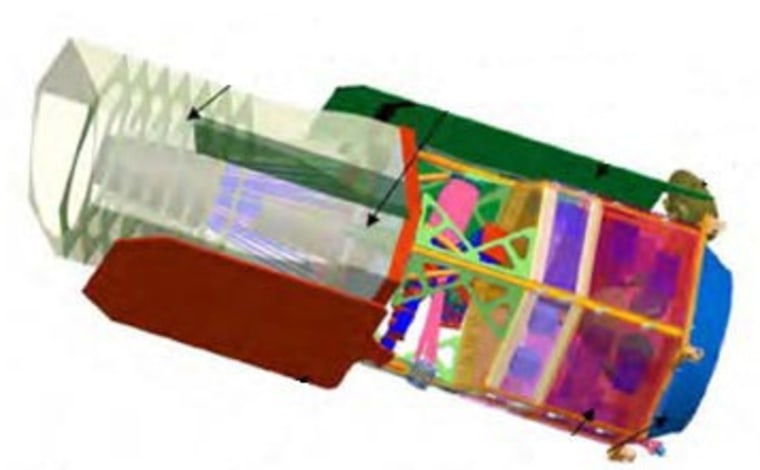A $1.6 billion space telescope that could reveal the nature of dark energy and identify Earth-like planets should be the top priority for astronomers and astrophysicists, according to a long-awaited report that lays out the pressing needs for the next 10 years of space science.
The Wide-Field Infrared Survey Telescope (WFIRST) would launch in 2020 as one of the next generation of telescopes that should target the early universe, search for nearby habitable planets and test the boundaries of fundamental physics, according to the Astro2010 Decadal Survey by the National Academy of Sciences.
"During the last Decadal Survey, exoplanets weren't a big element, and dark energy wasn't really a big deal," said Claire Max, an astronomer at the University of California in Santa Cruz and member of the Decadal Survey committee. "There are a whole lot of things that are really new."
The influential report sets a roadmap for scientific priorities and chooses the most promising telescope candidates for 2012-2021. Space- and ground-based research projects are split among large, midsize and small categories, so that WFIRST with its almost 5-foot (1.5-meter) field-of-view came in first within the large category of space projects exceeding $1 billion.
For comparison, NASA's next huge space observatory — the infrared James Webb Space Telescope — has an estimated cost of about $5 billion and is slated to launch in 2014. The iconic Hubble Space Telescope, which was launched in 1990, has a total cost of more than $10 billion including its construction, launch and 20 years of operations. Major interplanetary missions, like NASA's Cassini mission to Saturn and Galileo mission to Jupiter, also carried billion-dollar costs.
A new ground-based observatory that could scan the entire available sky every three nights topped report's list of vital, large ground projects that exceed $135 million. The $465 million telescope, called the Large Synoptic Survey Telescope, would scan each region of the sky 1,000 times over 10 years with an almost 28-foot (8.4-meter) aperture from its location in Chile. It is slated to see first light before the end of the decade.
Unlike past reports, this latest Decadal Survey considered the technological readiness and cost risk of each project. It also looked at previously considered projects such as LSST, which had matured since the most recent survey in 2001 and has now been dubbed the most "ready-to-go" among the ground projects.
New eyes in space
The report also found that an Explorer program that has supported small- and medium-sized missions such as NASA's Wide-Field Infrared Survey Explorer (WISE) ranked second in priority for large-cost space projects. The astrophysics component would receive an annual budget boost from $40 million to $100 million by 2015.

Third priority went to the Laser Interferometer Space Antenna, which consists of three formation-flying spacecraft to detect long-wavelength ripples in the fabric of space-time. Such ripples represent gravitational waves caused by events such as black hole mergers.
NASA would share $1.4 billion of the $2.4 billion total cost, assuming the European Space Agency joined in the effort. A successful 2012 launch of Europe's LISA Pathfinder mission could lead to a full-scale LISA launch by 2025.
Another international project, the International X-ray Observatory, would deploy a multi-part X-ray mirror with about 20 times more collecting area than any existing X-ray observatory. Current estimates put NASA's share of the $5 billion cost at $3.1 billion, with the rest split among ESA and the Japan Aerospace Exploration Agency.
The report's committee suggested that IXO could represent a promising top candidate for the next Decadal Survey, but only if the cost for NASA came down below $2 billion.
Stargazers on the ground
Earth-based projects also received careful scrutiny. The Mid-Scale Innovations Program that focused on small- to medium-scale experiments and facilities received second priority for the large ground projects.
Third priority went to a "Giant Segmented Mirror Telescope" in the 98-foot (30-meter) range. Such a telescope could have three times the diameter, 10 times the light-collecting area and 80 times the near-infrared sensitivity compared to existing telescopes, assuming that it used the adaptive optics technology which eliminates the atmosphere's blur effect.
Several giant telescopes slated for development include the $1.1 billion Giant Magellan Telescope sited for Chile, the $1.4 billion Thirty-Meter Telescope sited at Mauna Kea in Hawaii, and the European Extremely Large Telescope. The report's committee noted that the federal government can only afford to contribute to one of the two U.S. telescopes, and proposed that the National Science Foundation immediately choose one for future investment.
Finally, the report designated an Atmospheric Cerenkov Telescope Array as the fourth priority for large ground projects. Such a telescope would use large arrays of ground-based telescopes to detect blue flashes of Cerenkov radiation, which are caused by very high energy gamma-ray photons from cosmic sources smashing into the atmosphere.
A U.S. version of the array known as the Advanced Gamma-ray Imaging System was considered too expensive at more than $400 million, and so the report suggests that the U.S. join the European Cerenkov Telescope Array to share in costs and operations.
Making it happen
Government funding may remain one of the biggest uncertainties hanging over the report, despite the consensus among astronomers and astrophysicists about their scientific priorities.
"My concern is that if the federal budget remains very constrained, we won't be able to do any of this stuff," Max told Space.com.
The report did include some contingency planning about budgetary shortfalls and the projected availability of money from NASA, NSF and the Department of Energy. But Max pointed out that the numbers kept changing even as the committee worked on the report.
Still, she remained optimistic about not only the progress of the past decade, but also having the right instruments to make discoveries beyond what researchers know.
"This is a chance to exploit those [past discoveries] and still build enough general-purpose facilities so that you can find the big new things for the next decade," Max said.
